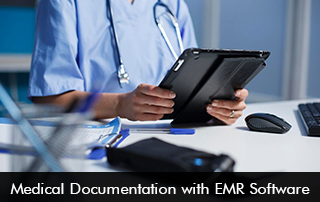Getting patient care right comes down to having accurate records. The U.S. CDC points out that clinical documentation mistakes can result in wrong diagnoses, hold-ups in treatment, and even harm patients. Problems with clinical documentation are a major cause of preventable errors in healthcare.
That’s where Electronic Medical Records (EMR) Software is proving to be a game-changer. Today’s EMR systems come with smart AI tools and voice recognition, making it easier and faster for clinicians to keep precise records.
AI-Powered Functionalities in EHR Software
Artificial intelligence (AI) is revolutionizing the way electronic medical record software operates. AI capabilities in EMR Software can automatically fill in patient charts by examining laboratory results, past visit notes, and diagnostic codes.
Imagine a system that finishes sentences while providers type, flags potential errors as they go, and offers intelligent suggestions to speed things up. These AI features in EHR Software make documentation quicker and more uniform, which means doctors and nurses spend less time on paperwork and more time caring for patients. Plus, these tools help ensure that everyone on the healthcare team is on the same page.
NLP Tools in EMR Software Systems
Certain EMR systems such as athenahealth EMR Software have leveraged the power of Natural Language Processing (NLP). Think of it as teaching computers to understand human language. With NLP, the EHR software can take a clinician’s written notes and turn them into organized, structured data. This doesn’t just make writing up patient charts faster; it also makes it easier to find important information later and ensures that billing is done accurately.
EHR Software with Voice Recognition Capabilities
Voice recognition tools, such as Nuance’s Dragon Medical or the built-in speech-to-text features in modern EHR Software Systems, enable clinicians to dictate notes without using their hands. This greatly reduces the time spent typing and facilitates real-time charting during or immediately after patient visits. These tools are particularly beneficial in fast-paced settings like emergency departments and urgent care clinics.
Benefits of Clinical Documentation with EMR Software
The following advantages can be reaped when healthcare providers make use of smart documentation features in their electronic health records software:
- Streamlined and accurate documentation
- More time can be spent on patient interactions
- Improves patient satisfaction scores as undivided attention can now be given to be
- Enhanced communication can prevail
- EMR Software documentation has structured formats that can help with compliance.
- When clinical documentation is accurate patient safety can be enhanced, boosting overall health outcomes.








